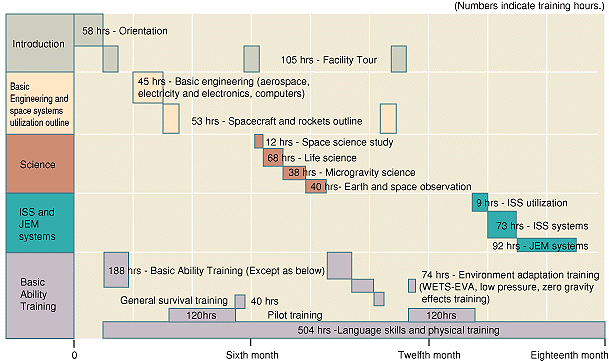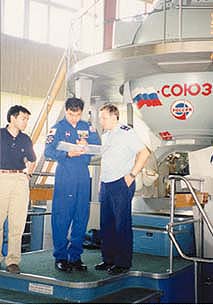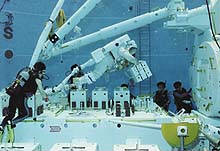
| Basic Training for
International Space Station Astronaut Candidate |
|
Lectures and Hands-on Training in a Variety of Fields
- JAXA's Basic Training can be broadly broken down into the following
four areas :
- Necessary general knowledge of space engineering and spacecraft for
astronauts (introduction).
- Science related knowledge necessary to perform experiments in orbit.
- Outline of on-orbit operation of ISS and Kibo systems.
- Maintaining and improving skills necessary for astronauts (basic training
covering general survival techniques, aircraft pilot training, SCUBA training,
language skills, and physical conditioning).
Areas 1 through 3 will be taught primarily by lectures but with some actual
practice. Area 4 will be taught primarily by astronaut candidates actually
performing or participating in specific tasks. JAXA's Basic Training for
astronaut candidates will cover about 230 subjects and require about 1,600
hours of instruction.
Figure.1 is an example of Basic Training Flow.
Figure.1 Basic Training Flow (Example)

1.Introduction, Basic Engineering and Outline of Space Systems
The purpose of this training is to provide
general knowledge necessary for Japanese astronauts. Basic engineering
knowledge needed in spacecraft system training or in actual operation,
and summaries of the Space Shuttle, Soyuz, and H-II rocket will be included.
Most of the courses will be taught by JAXA personnel, including Japanese
astronauts. Personnel from universities or research institutes will teach
specific courses.
Training on Russian spacecraft such as Soyuz will be conducted at the Gagarin
Cosmonaut Training Center (GCTC) in Russia. In order to acquire information
for setting up this training plan, astronaut Noguchi investigated GCTC
in the summer of 1998 and experienced Russian astronaut training. |
 |
| Astronaut Noguchi (center) receives Soyuz
simulator training at Russia's Astronaut Training Center. |
2.Science
In this area, the astronaut candidates will learn the general principles
of Life Sciences, Microgravity Science, Earth Observation, and Space Science
for experiments and observations aboard ISS and for the related training.
This includes not only receiving lectures, but also actually performing
experiments and conducting observations. Lecturers will be those from various
JAXA and university research centers.
3.ISS and Kibo Systems
Astronaut candidates will learn outlines of on-orbit ISS system operations
and utilization. After completing basic training, astronauts will enter
the advanced training and increment-specific training phases (see the April
article) where they will receive actual ISS system operation and utilization
training using training facilities. They will also conduct training to
master operating equipment and performing experiments on orbit. The training
will also provide Japanese astronaut candidates as much knowledge of Japanese
Experiment Module (Kibo) systems as possible.
4.Basic Ability Training
 |
| Weightless simulation test in the Weightless
Environment Testing System (WETS). |
Basic Ability Training means training other than described above and includes
maintaining and improving techniques and abilities necessary for astronauts
and includes a variety of fields. For example, it includes training in
English, the official language used during their stays at ISS. They also
receive instruction in the Russian language for the training which will
be conducted in Russia. These two languages training represents one-fourth
of the total Basic Training (400 hours in total).
It is important for astronauts to maintain a good physical condition, so
they will also learn to manage their own health and provide first aid.
They will also undergo physical training regularly three times a week.
Astronauts will also receive "Crew Resource Management" training
in which pilots learn to judge conditions in the cockpit, resolve problems,
and make decisions. They will also be trained in photographic techniques
for taking photographs from orbit, media relations training, radio communications
in English, and pilot training.
There is also specialized training for astronauts. This includes survival
training, EVA training, and hyperbaric (altitude) chamber training. Survival
training is necessary in case of an emergency and they must return from
space. It teaches techniques to survive in remote locations both on land
and in the sea. EVA covers basic operations for activities outside the
ISS. For this purpose, astronauts don a special "space suit"
and train in a simulated weightless environment underwater (see Fig. 2).
Hyperbaric (altitude) chamber training is provided in case astronauts experience
a depressurization or a low-pressure environment.
Acquiring Basic Techniques of Manned Space Development through and with
the Astronauts
The above astronaut training is a unique field in techniques needed for
manned space development. This basic training that is actually being conducted
by JAXA for the first time is very significant for advancing Japanese
space development. Furthermore, by training Japanese astronaut candidates
in Japan, Japan will accumulate training experience and Japanese people
will feel closer to the astronauts because they will be training with them.
However, because there are fewer astronaut trainees in JAXA than in NASA,
the astronauts in Japan will have fewer opportunities to encourage and
support each other and to acquire knowledge of various fields. For this
purpose, Japanese astronauts training in Japan should mingle with senior
Japanese astronauts training in NASA Houston as much as possible and with
astronauts of other countries. Furthermore, JAXA hopes to develop Japanese
astronauts with wide perspectives. In this way, the basic training in Japan
will be a very significant means of accumulating experience for trainers
also.
Basic Training Topics
| Field |
Content |
Time |
| Introduction |
Orientation |
37 |
| Outline of Training Plan |
5 |
| Present Space Activity Status And Framework |
6 |
| Space Development of the World |
7 |
| Space Development of Japan |
3 |
| Facility Tours |
105 |
| Basic Engineering (outlines) |
Aerospace Engineering |
10 |
| Electrical and Electronics Engineering |
18 |
| Computers |
17 |
| Space Systems Utilization and Outlines |
Space Shuttle |
10 |
| Russian Spacecraft and Rockets |
39 |
| Arian |
1 |
| H-II |
3 |
| ISS and Kibo Systems |
ISS Utilization |
9 |
| ISS Systems |
73 |
| Kibo Systems and utilization training |
92 |
| Science |
Space Science Study |
12 |
| Life Science |
71 |
| Microgravity Science |
39 |
| Earth and Space Observation |
40 |
| Basic Ability Training |
General Survival Training |
40 |
| Swimming |
5 |
| SCUBA |
68 |
| Psychological Support Program |
31 |
| Health Management |
24 |
| Physical Training |
104 |
| Zero-gravity Simulation(Parabolic flight in jet aircraft) |
8 |
| Hyperbaric (altitude) Chamber |
27 |
| WETS and EVA Training (Underwater training wearing
modified space suit for EVA activities) |
39 |
| Aircraft Training |
240 |
| Photography |
24 |
| English |
200 |
| Russian |
200 |
| Japanese Media Relations |
17 |
| English Media Relations |
8 |
Last Updated : May. 20, 1999
|
